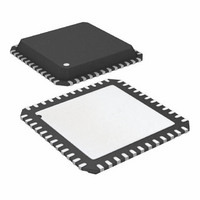ADUC7034BCPZ-RL Analog Devices Inc, ADUC7034BCPZ-RL Datasheet - Page 128

ADUC7034BCPZ-RL
Manufacturer Part Number
ADUC7034BCPZ-RL
Description
IC,Battery Management,LLCC,48PIN,PLASTIC
Manufacturer
Analog Devices Inc
Series
MicroConverter® ADuC7xxxr
Datasheet
1.ADUC7034BCPZ-RL.pdf
(136 pages)
Specifications of ADUC7034BCPZ-RL
Core Processor
ARM7
Core Size
16/32-Bit
Speed
20.48MHz
Connectivity
LIN, SPI, UART/USART
Peripherals
POR, PSM, Temp Sensor, WDT
Number Of I /o
9
Program Memory Size
32KB (32K x 8)
Program Memory Type
FLASH
Ram Size
4K x 8
Voltage - Supply (vcc/vdd)
3.5 V ~ 18 V
Data Converters
A/D 2x16b
Oscillator Type
Internal
Operating Temperature
-40°C ~ 115°C
Package / Case
48-LFCSP
Lead Free Status / RoHS Status
Lead free / RoHS Compliant
Eeprom Size
-
Lead Free Status / RoHS Status
Lead free / RoHS Compliant
ADuC7034
BSD COMMUNICATION FRAME
To transfer data between a master and slave, or vice versa, the
construction of a BSD frame is required. A BSD frame contains
seven key components: pause/sync, direction (DIR) bit, slave
address, register address, data, parity (P1 and P2) bits, and
acknowledge from the slave.
If the master is transmitting data, all bits except the acknowledge bit
are transmitted by the master.
If the master is requesting data from the slave, the master
transmits the pause/sync, direction bit, slave address, register
address, and P1. The slave then transmits the data bytes, the P2,
and the acknowledge in the following sequence:
1.
2.
3.
4.
5.
6.
7.
8.
The acknowledge is always transmitted by the slave to indicate
whether the information was received or transmitted.
Table 95. BSD Protocol Description
Pause
3 bits
BSD Example Pulse Widths
An example of the different pulse widths is shown in Figure 53.
For each bit, the period for which the bus is held low defines
what type of bit it is. If the bit is a sync bit, the pulse is held low
for one bit. If the bit is 0, the pulse is held low for three bits. If
the bit is 1, the pulse is held low for six bits.
Pause: ≥ three synchronization pulses.
DIR: signifies the direction of data transfer.
DIR = 0 if master sends request.
DIR = 1 if slave sends request.
Slave address.
Register address: defines register to be read or written.
Bit 3 is set to write and cleared to read.
Data: 8-bit read only receive register.
P1 and P2.
P1 = 0 if even number of 1s in eight previous bits.
P1 = 1 if odd number of 1s in eight previous bits.
P2 = 0 if even number of 1s in data-word.
P2 = 1 if odd number of 1s in data-word.
Acknowledge.
ACK = 0 if transmission is successful.
DIR
1 bit
Slave
Address
3 bits
4 bits
Register
Address
P1
1 bit
8 bits
Data
P2
1 bit
Rev. B | Page 128 of 136
ACK
1 bit
If the master is transmitting data, the signal is held low for the
duration of the signal by the master. An example of a master
transmitting 0 is shown in Figure 54. If the slave is transmitting
data, the master pulls the bus low to begin communication. Next,
the slave must pull the bus low before t
the bus low until either t
bus is released by the slave. An example of a slave transmitting a
0 is shown in Figure 55.
Typical BSD Program Flow
Because BSD is a PWM communication protocol controlled by
software, the user must construct the required data from each bit.
For example, in constructing the slave address, the slave node
receives the three bits and the user constructs the relevant address.
When BSD communication is initiated by the master, data is
transmitted and received by the slave node. A flow diagram
detailing this process is shown in Figure 56.
BUS PULLED LOW
BY MASTER
BUS PULLED LOW
BY MASTER
t
SYNC
t
t
0
1
t
t
SYNC
SYNC
Figure 54. BSD Master Transmitting 0
Figure 55. BSD Slave Transmitting 0
t
t
0
0
Figure 53. BSD Bit Transmission
0
or t
1
has elapsed, after which time the
BUS HELD LOW
BY SLAVE
RELEASED BY
MASTER
BUS RELEASED BY
SLAVE AFTER
BUS RELEASED BY
MASTER AFTER
SYNC
elapses and then hold
t
0
t
0












